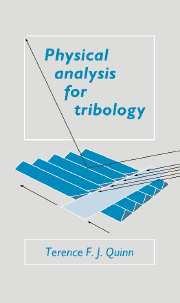Book contents
- Frontmatter
- Contents
- Preface
- Nomenclature list
- 1 Tribology
- 2 Macroscopic physical techniques
- 3 Microscopic physical techniques for studying atomic arrangement
- 4 Microscopic techniques for studying atomic structure
- 5 The analysis of lubricant films
- 6 The analysis of surface temperatures in tribo-systems
- 7 The analysis of pitting failures in tribo-systems
- 8 The analysis of oxidational wear in tribo-systems
- 9 The application of physical techniques to selected ceramic tribo-systems
- References
- Index
6 - The analysis of surface temperatures in tribo-systems
Published online by Cambridge University Press: 29 October 2009
- Frontmatter
- Contents
- Preface
- Nomenclature list
- 1 Tribology
- 2 Macroscopic physical techniques
- 3 Microscopic physical techniques for studying atomic arrangement
- 4 Microscopic techniques for studying atomic structure
- 5 The analysis of lubricant films
- 6 The analysis of surface temperatures in tribo-systems
- 7 The analysis of pitting failures in tribo-systems
- 8 The analysis of oxidational wear in tribo-systems
- 9 The application of physical techniques to selected ceramic tribo-systems
- References
- Index
Summary
Thermal aspects of sliding
Introduction
There have been many attempts to measure the temperature of the interfaces of sliding surfaces, both by direct and indirect measurements. Early direct measurements tended to involve the dynamic thermocouple, for example Shore (1925), Herbert (1926) and Furey (1964). Such measurements tend to be restrictive as regards the choice of sliding material combinations. They are also insensitive to the very rapid transients that occur during sliding. More recent direct measurements involve the use of optical photography through the transparent member of a sliding pair (Quinn and Winer, 1985) or the use of an infra-red detector (Meinders, Wilcock and Winer, 1984). We will describe both types of measurements in more detail in later sub-sections. The indirect measurements of surface temperature have tended to be a mixture of theory and experiment, for example see Ling and Pu (1964) and Archard (1959). Occasionally, temperature-dependent transitions in tribo-element phases have been used to give an indirect indication of the temperatures of sliding, for example see Quinn (1968), a paper in which the proportions of the various iron oxides in the wear debris were used to estimate the most probable temperature of formation of those oxides. We will describe the X-ray analysis of wear debris in a later sub-section (Section 6.2).
- Type
- Chapter
- Information
- Physical Analysis for Tribology , pp. 291 - 359Publisher: Cambridge University PressPrint publication year: 1991
- 1
- Cited by



